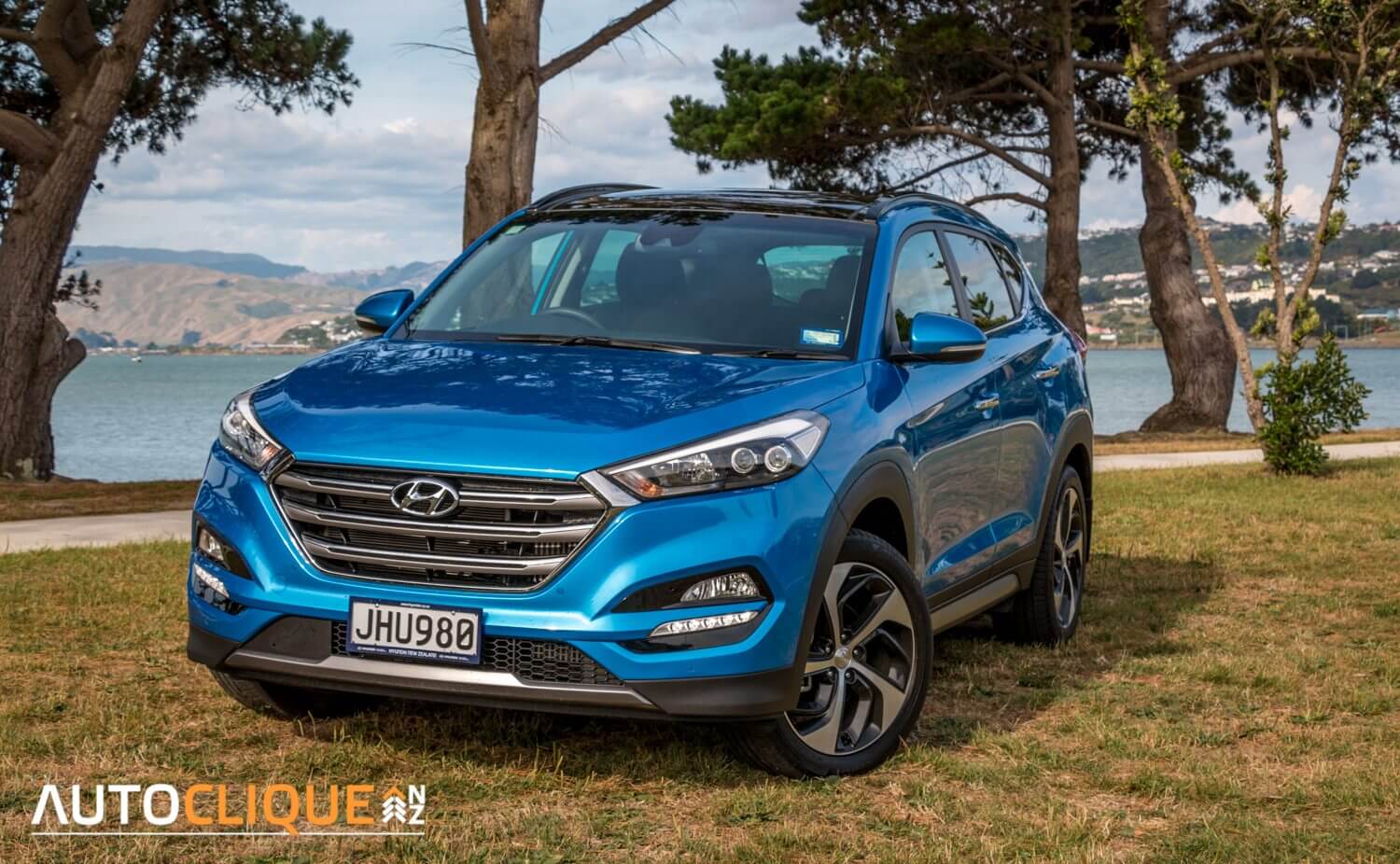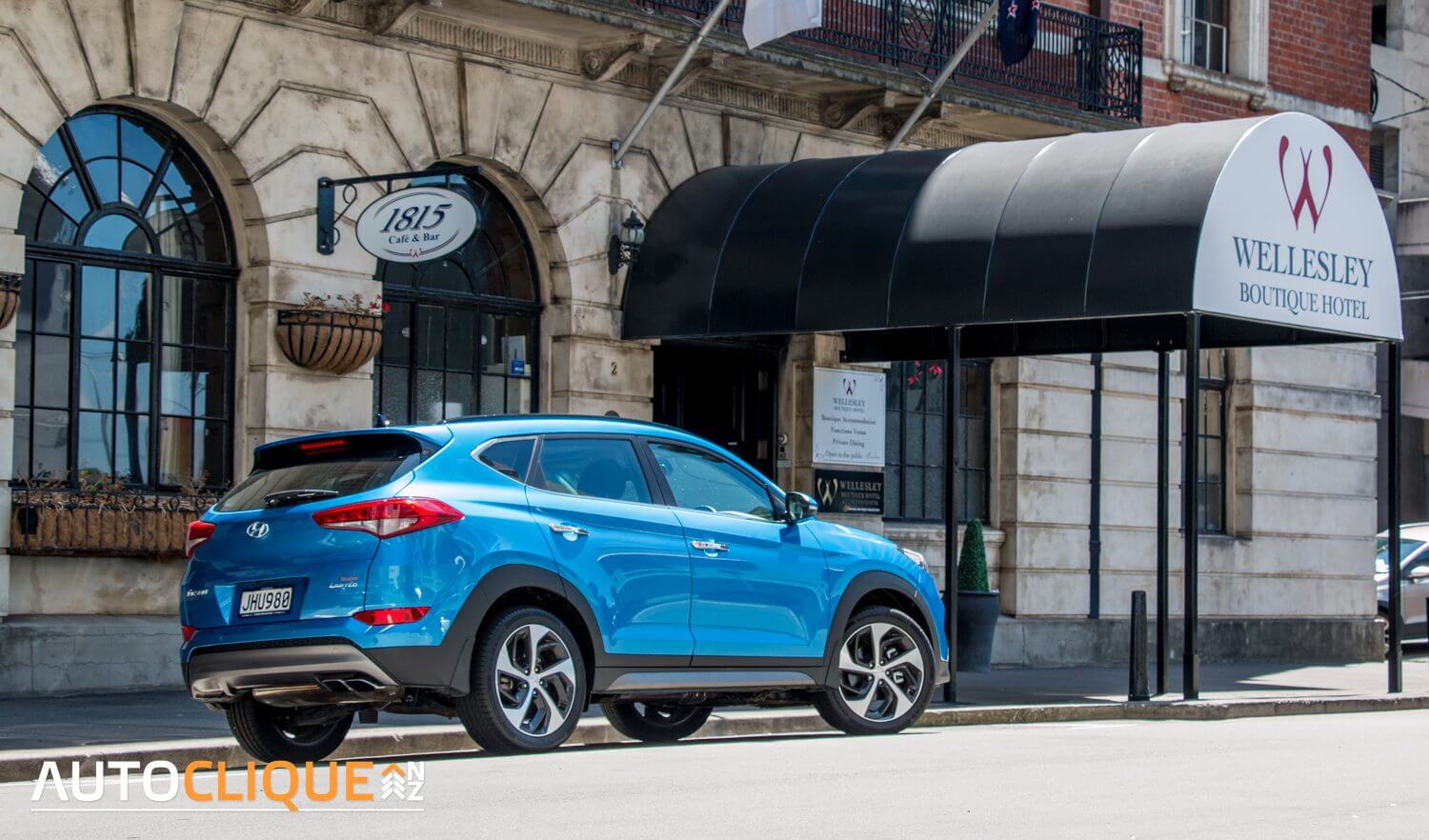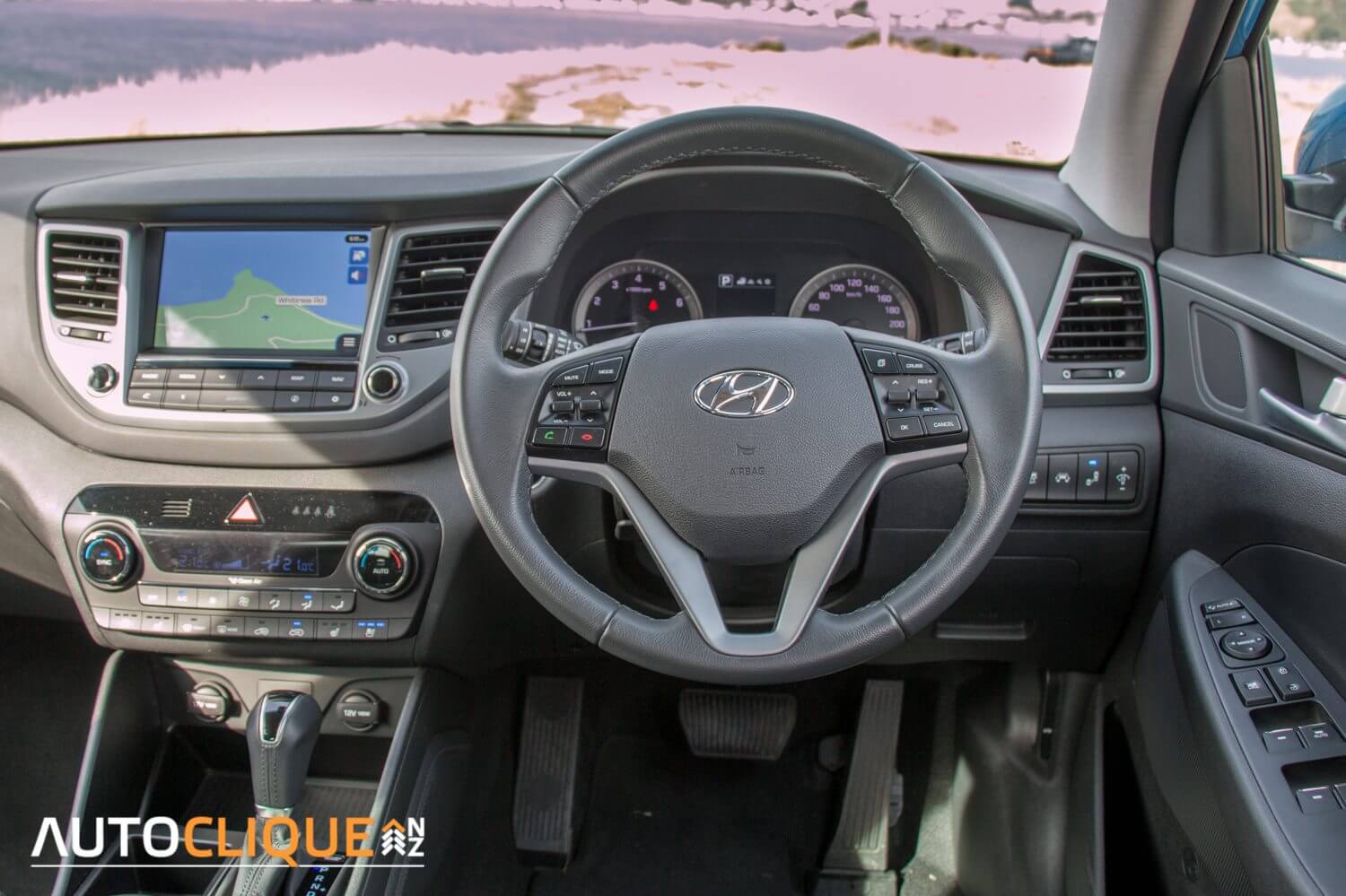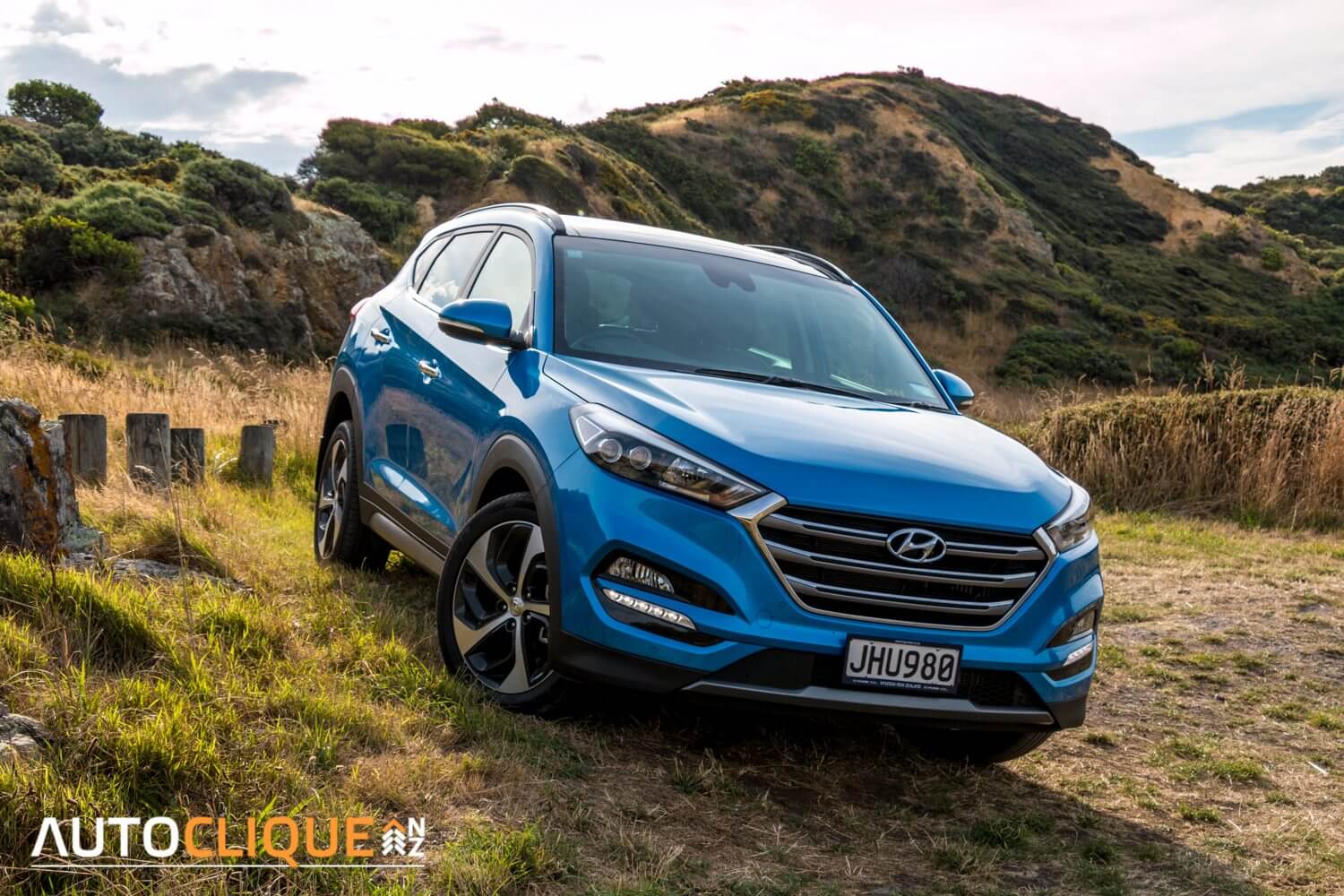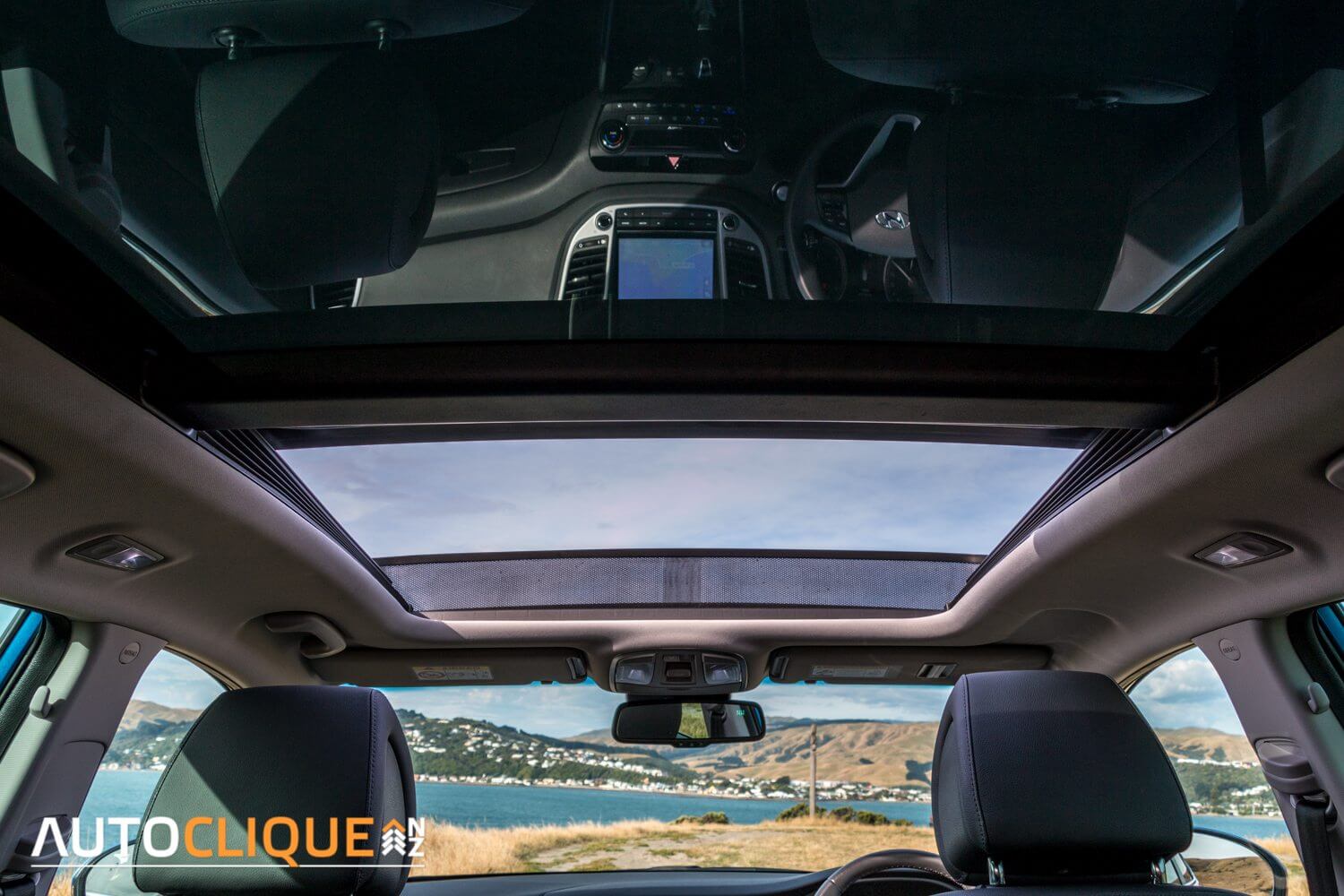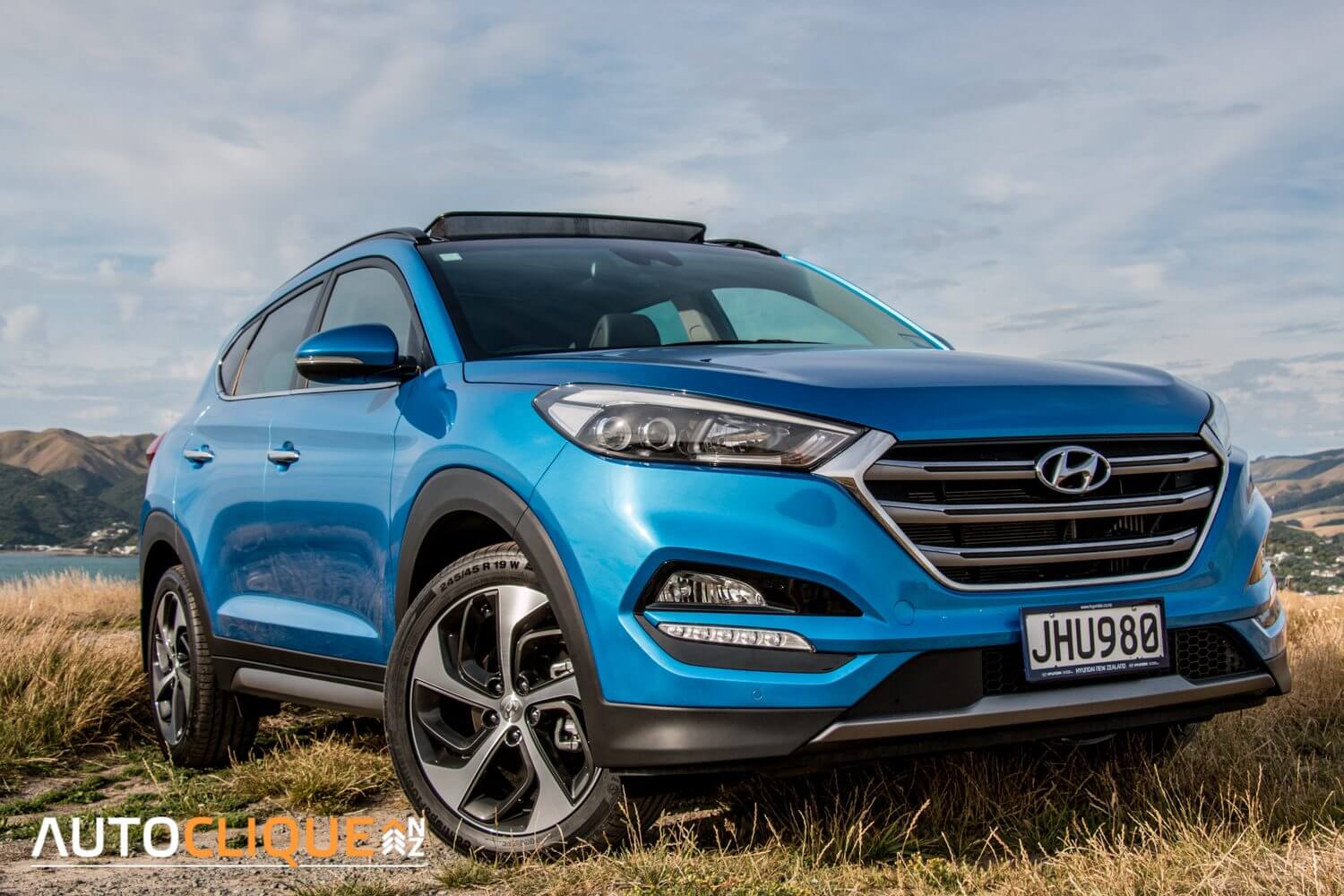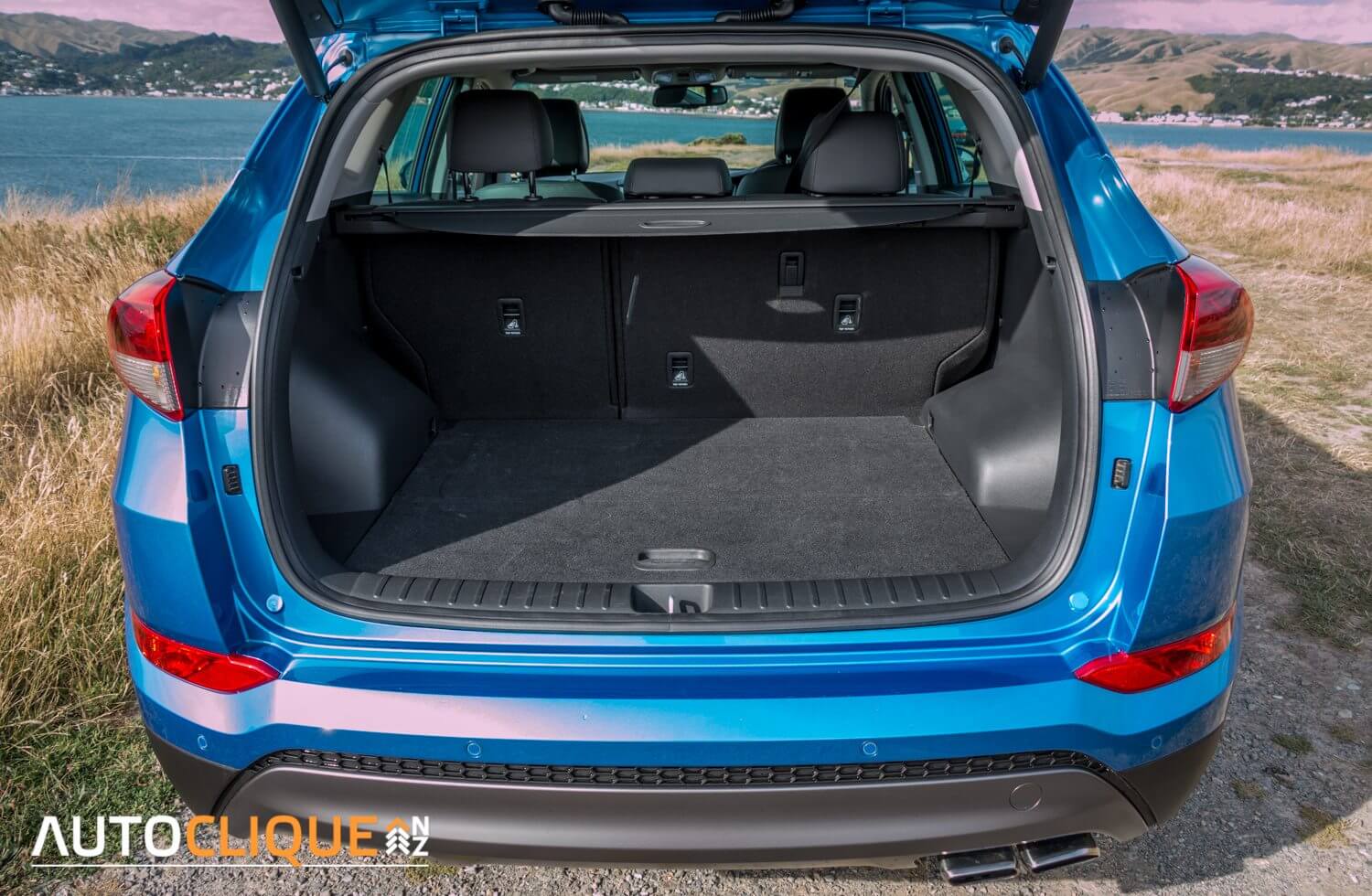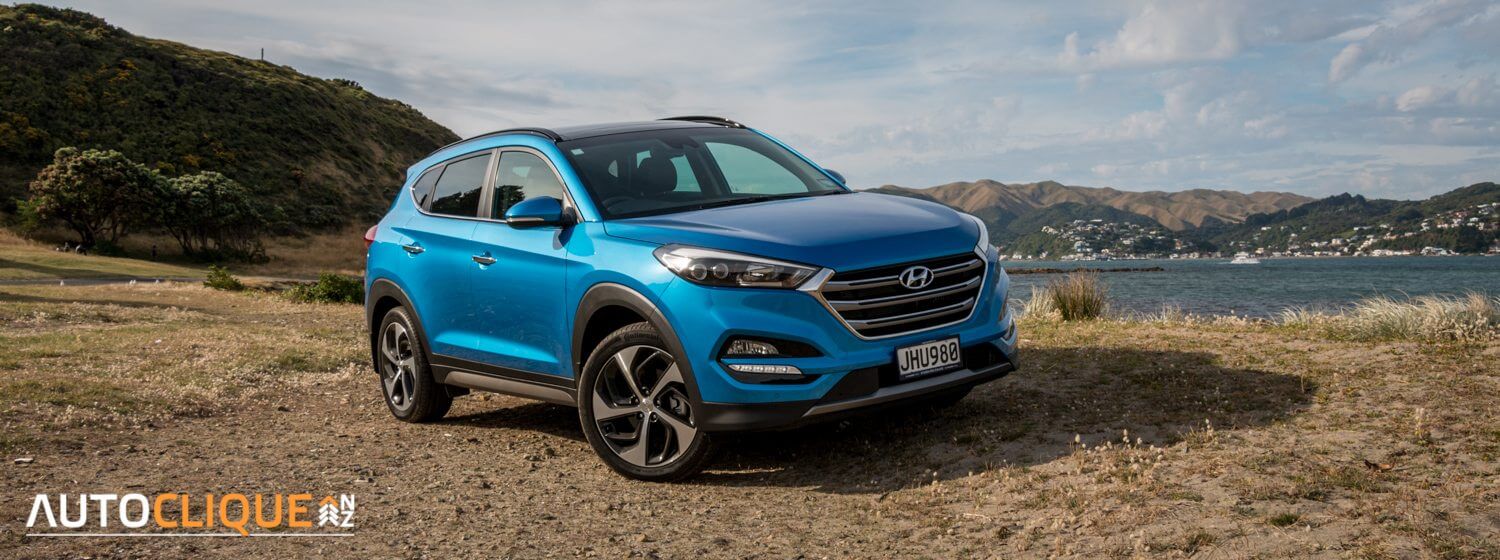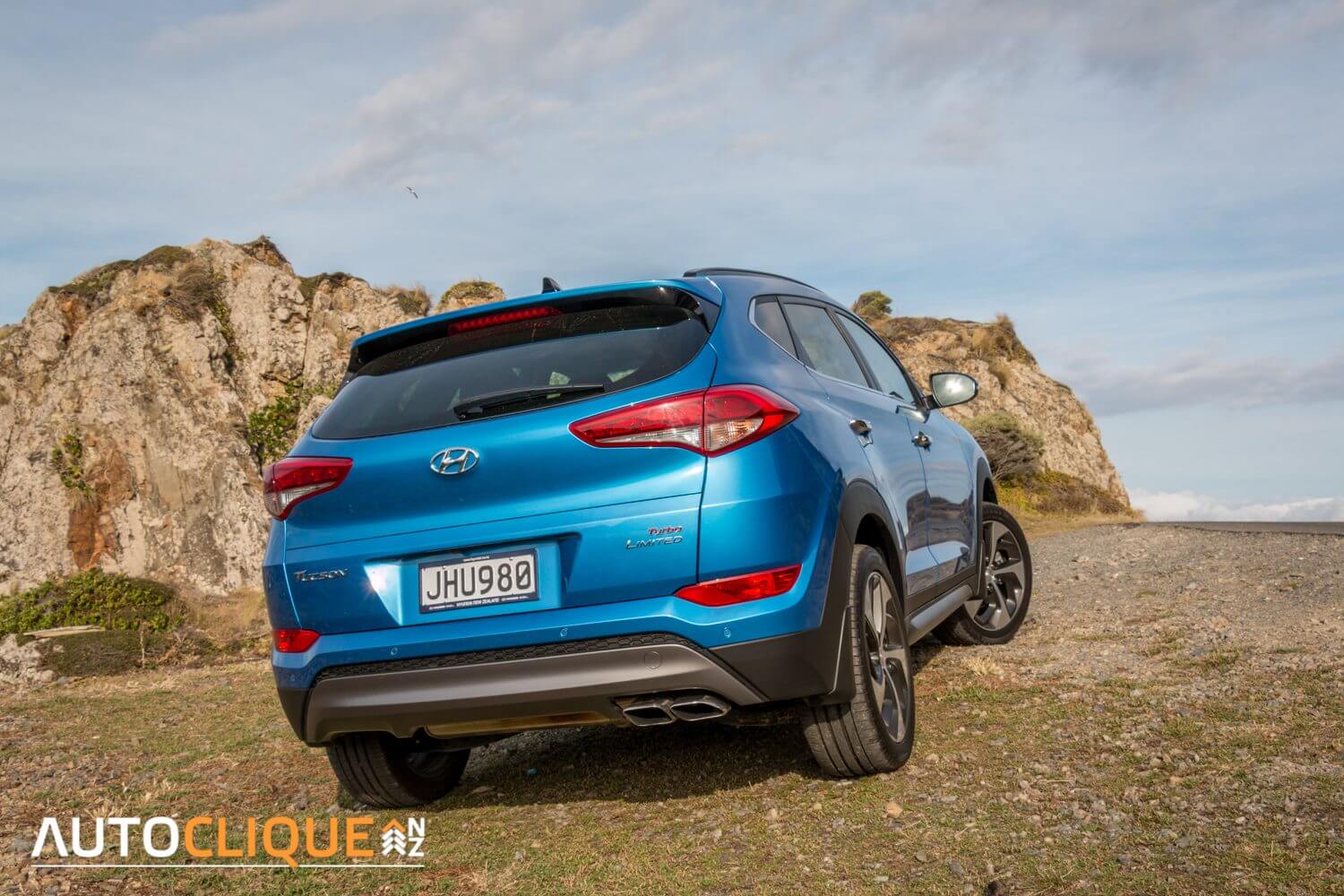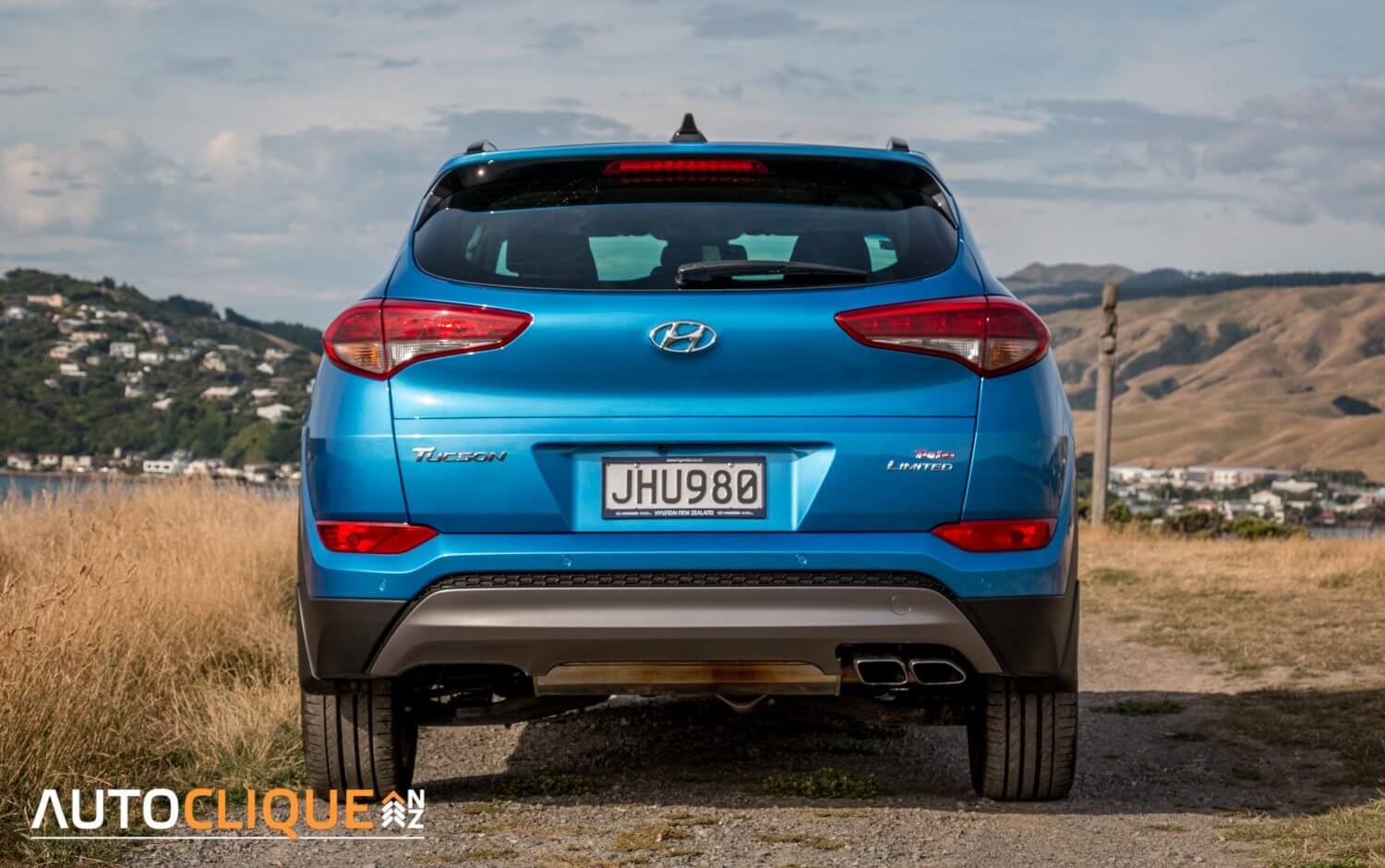The Hyundai Tucson won two awards in the AA’s Car of the Year 2015 – Best Medium SUV and the People’s Choice Trophy. The Tucson has been around since 2004 and this 2015 model, which is built in the Czech Rebublic, is the third generation. Our test car was the 1.6 turbocharged petrol version, in the top Elite Limited spec.
The Tucson has some impressive safety technology included: The usual ABS, Electronic Stability Control and Electronic Brakeforce Distribution, plus Lane Keep Assist, Autonomous Emergency Braking, Blind Spot Detection, Rear Cross Traffic Alert and Advanced Traction Cornering Control. It doesn’t just have the 4×4 look either. There’s a lockable diff so the power can be split 50:50 front to rear, as well as Downhill Brake Control.
Hyundai’s timing was excellent as on the day our test car was available I had to drive from Wellington to Feilding and back, the perfect test run!
First Impressions
Our Tucson came in a rather lovely shade of bright blue which Hyundai call Ara Blue, and I think really suits the car. The other available colours are all much more muted tones – mostly silvers and greys. It’s a good looking car; Hyundai have done a great job of disguising the relatively bulky SUV proportions by using big arches, and slashes moulded into the metal. I also liked some of the details, such as the twin chrome-tipped exhausts, nicely integrated LED daytime running lights, honeycomb lower grilles, and two-tone 19” wheels. Something I haven’t seen on a car for a while was a bright red “Turbo” badge on the back, though I guess it matches the Veloster Turbo badging.
Inside, the Tucson is really very pleasant. Comfortable leather seats, the fronts with eight way electric adjustment, plus electric lumbar adjustment for the driver. The driver also gets a leather knee pad on the side of the centre console, and the leather trimmed steering wheel adjusts (manually, not electrically)for reach and height. The 60:40 split folding rear seats are two-stage reclinable and have loads of legroom. There’s a pull-down armrest in the centre, as well as ISOfix mounts and 3-point tether anchors for child seats.
The dash layout is clear and easy to use with two big dials for speedo and rev counter and a central colour screen for trip computer and other displays, such as tyre pressure. I liked to keep it set as a large digital speedo. There’s an 8” touch screen in the centre console for the satnav and reversing camera, and nice clear buttons for the media system and aircon controls. At the bottom in a little cubby there are two power sockets plus USB and Aux inputs for the stereo. The stereo has no CD player, just these inputs plus Bluetooth and a radio.
Setting off from Hyundai, I was surprised at how quick the Tucson’s acceleration felt. Our test car had the 1.6 litre turbo engine mated to a seven speed dual clutch transmission. It’s a great combination, giving rapid, almost seamless gear changes. The acceleration is constant with no obvious lag from the twin scroll turbo. On the motorway, the Tucson is very refined and surprisingly quiet. I expected more road noise, especially after experiencing the BMW X1 on 19s, but Hyundai have done a better job here than BMW in damping the noise.
What’s it like to live with?
I only had the Tucson for a couple of days, but managed to clock up 400 km or so on a long trip and several shorter ones. It’s a great car to live with, and very practical as a family car. The high driving position and big windows give good visibility, though the A pillars seem pretty chunky and can get in the way at roundabouts sometimes.
On a longer trip, the Tucson was excellent. The driving position and smooth ride make for a pleasant experience. The interior is spacious. The six speaker stereo is very clear, but a little light on bass; a boot mounted subwoofer like the Santa Fe would make it perfect.
We drove to the airport to pick up a friend, where I demonstrated the motorised tailgate. It can be opened and closed either from the remote, a button by the driver’s knee, or from buttons on the tailgate itself. There’s a decent sized boot which comes with bag hooks, a cargo net and another 12v power socket. Underneath the padded and insulated boot floor is a full-sized alloy spare wheel, fire extinguisher, jack and first-aid kit. Most of these things are usually present as standard in a car.
On the way back from the airport I let the Mrs drive and tried out the back seat. It was a hot day, and I was glad of the rear aircon vent which blows into the back seat area. The back seat is the best place to appreciate the full-length tinted glass roof. A large front section of the roof tilts and slides open, and a wind deflector pops up at the front. Even with the roof fully open, the deflector did its job well. When closed, a full-length cloth blind covers up the roof. One thing I found mildly irritating is that it only had two positions – closed with the blind or fully open. It has to be manually stopped to have it in between – say with the blind open but glass closed.
We set off to Feilding, trying out the satnav on the way. The satnav works well, re-calculates quickly if you choose to ignore it and gives clear directions. It receives traffic updates and can re-calculate the route to avoid the jams. It also also gives a constant reminder of the current road speed by displaying a circular speed sign on the left of the map. In built-up areas it even has 3D textured buildings for the main landmarks. There’s a speed warning system which tells you if you exceed the speed limit by a pre-set amount. It kept getting confused near car parks where the road speed was 50 but it thought I was in the car park’s 20kph limit. I turned it off after four or five false alarms.
I quickly got used to the steering mounted controls for the media system and phone. At first it looks like a lot of buttons, but they’re intuitive and easy to use. The cruise control is also operated from steering wheel-mounted buttons. It works as you’d expect but the Tucson has my usual gripe with cruise systems – why doesn’t it show the set speed on one of the digital displays? This would be useful! The wheel itself is trimmed in leather and is nicely shaped, with comfortable grips.
On the open road, another safety system becomes more apparent. The Tucson has Lane Departure Warning, which beeps if you go over a white line without indicating, but it also has Lane Keep Assist as part of the same system. What it does is actively compensates for any lane drift by nudging the steering wheel in the right direction. It won’t steer right around the corners for you but I found that on almost every bend on the highway it started to steer a fraction of a second before I did, which was a little bit freaky. It takes a bit of getting used to but on the way back on very dark roads late at night I found it quite reassuring to have on. It wanted to drive closer to the centre of the road than I did sometimes, and I occasionally found myself fighting its inputs.
In the hot weather, the air cooled front seats were great to have, helping to avoid the sweaty back that can happen on leather seats. They’re also heated with three stage adjustment, and the rear seats are two stage heated..
The Tucson has self-levelling LED headlights, with cornering lights that flick on and off as you go around bends. These are particularly useful when parking, or taking sharp turns on unlit roads.
Other useful night time features include puddle lights, LEDs in the door handles which illuminate as you walk up to the car, and headlights which light up as you approach, and stay on for a while after the car is locked. There are also parking sensors front and rear, which combined with the display which comes up in front of the driver are really good when you can’t see exactly where the bumpers are.
On my way to return the Tucson I had the chance for a quick blast on a curvy back road. I put it into Sport mode, slotted the shifter sideways into manual and put my foot down. The 1.6 turbo engine has a nice growl to it when revved, and the DSG transmission won’t let you over-rev it, shifting up just before the red line even in manual mode, but responding quickly to downshifts when requested. I immediately started grinning, this may be a fairly tall SUV but it handles like a car, and that engine note is quite addictive. You can have some fun in this thing!
I was a little bit reluctant to hand the Tucson back so soon, but it had to be driven up to Auckland the next day. If I’d had the time I would have driven it there myself. The car I drove had about 8000km on the odometer, and had some evidence of going off road on the subframe and suspension, but it looked and felt like a brand new car. Nothing out of place, no rattles or squeaks, a nice solid thunk when the doors were shut, all evidence of a well built car.
What it’s up against
It seems like every manufacturer has a similar vehicle to the Tucson, so many to choose from!
| Brand / Model | Engine | Power | Drivetrain | Fuel L/100km | 0-100km/h | Price Highest to Lowest |
| BMW X1 | 2.0l 4 cyl turbo | 135kW/270Nm | RWD | 6.7 | 7.7s | $70,400 |
| Volvo XC60 | 2.0l 4 cyl turbo | 180kW/350Nm | FWD | 6.7 | 7.2s | $69,990 |
| Jeep Cherokee Limited | 3.2l 6 cyl | 200kW/316Nm | 4WD | 10 | N/A | $61,990 |
| Kia Sorento | 3.3l 6 cyl | 199kW/318kW | FWD | 9.9 | 8.2s | $60,990 |
| Audi Q3 | 1.4l 4 cyl turbo | 110kW/250Nm | FWD | 7.7 | 8.9s | $59,990 |
| Hyundai Tucson Elite Limited | 1.6l 4 cyl turbo | 130kW / 254Nm | 4WD | 7.7 | 8.8s | $59,990 |
| Subaru Forester Premium | 2.0l 4 cyl turbo | 177kW/350Nm | 4WD | 8.5 | 7.5s | $59,990 |
| Mercedes GLA180 | 1.6l 4 cyl turbo | 90kW/200Nm | FWD | 5.7 | 9.0s | $59,900 |
| toyota RAV4 | 2.5l 4 cyl | 132kW/233Nm | 4WD | 8.5 | 9.4s | $58,990 |
| Honda CRV Sport Wagon NT+ | 2.4l 4 cyl | 140kW/222Nm | 4WD | 8.7 | N/A | $58,890 |
| Mazda CX-5 | 2.5l 4 cyl | 138kW/250Nm | 4WD | 7.4 | N/A | $54,895 |
| Mitsubishi Outlander | 2.4l 4 cyl | 126kW/224Nm | 4WD | 7.5 | N/A | $54,490 |
| Holden Captiva | 3.0l 6 cyl | 190kW/288Nm | 4WD | 10.1 | N/A | $54,490 |
| Ford Kuga Titanium | 2.0l 4 cyl turbo | 178kW/345Nm | 4WD | 8.8 | N/A | $53,490 |
| Nissan X-Trail | 2.5l 4 cyl | 126kW/226Nm | 4WD | 8.3 | N/A | $53,290 |
The good and the bad.
| Pros | Cons |
|
|
What do we think?
The Tucson has an impressive level of technology, for both comfort and safety. It’s solidly built, refined and comfortable. There’s plenty of room for the family and luggage. This is a crowded market segment but the Tucson stands up very well indeed, it’s a great car at a very good price.
Does it deserve to be car of the year in its class? I think it does!
Rating – Chevron rating 4.5 out of 5
| Vehicle Type | Small/Medium SUV |
| Starting Price | $47,990 + On road costs |
| Tested Price | $59,990 + On road costs |
| Engine | 1.6 litre 16 valve DOHC 4 cylinder petrol with dual CVVT (Continuously Variable Valve Timing) with Twin Scroll Turbocharger |
| Transmission | 7-speed Dual Clutch Automatic (DCT) |
| 0 – 100 kph | 8.8 seconds |
| Kerb Weight | 1,575-1,690 kg |
| Length x Width x Height | 4475 x 1850 x 1660 mm |
| Cargo Capacity | 488 Litres – rear seats up |
| Fuel Tank | 62 litres |
| Towing Capacity | Braked – 1600kg
Unbraked – 750kg |
| ANCAP Safety Ratings | 5 stars |
| Warranty | 3 year / 100,000 km mechanical warranty
3 year / 100,000 km roadside assistance 10 year / 200,000 km anti perforation corrosion body warranty |


